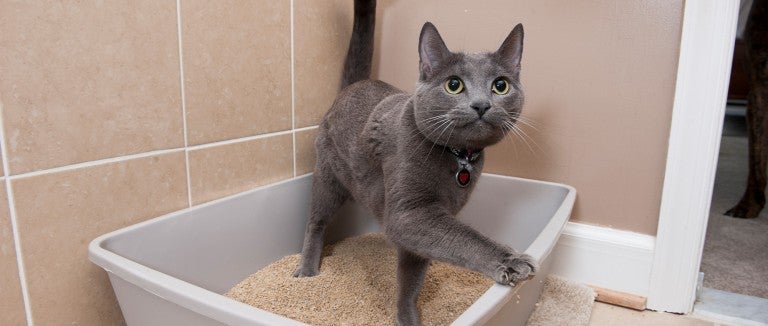Cats can be finicky about their bathroom habits, so keeping your cat's litter box up to their standards is very important. You don’t need to teach your cat what to do with a litter box; instinct will generally take over. You do need to provide an acceptable, accessible litter box and show your cat where it is. The following suggestions from cat behaviorist Matt Wildman should keep your cat from "thinking outside the box."
How many litter boxes should I use?
One litter box for each cat in the home plus one more, in different locations throughout your home. This ensures that if one cat is being bullied by another, they will still feel safe using the litter box.
It's not possible to designate a personal litter box for each cat in your household; cats use any litter box that's available. That means a cat may occasionally refuse to use a litter box after another cat has been in it, so you’ll need to keep each litter box clean.
What type of litter box should I use?
When cats eliminate, they are releasing scents that can lead to unwanted attention from other cats or potential predators, says Wildman. They want to feel safe, which means being able to see their surroundings and view potential “escape” routes, and they want the area to be clean, which means it needs to be regularly scooped.
Boxes should be large enough for the cat to easily turn around in without touching the sides of the box, low enough that they can easily get in and out and placed in a quiet but accessible area of the home away from food and water bowls. Try a few types of boxes and litters to find which your cat prefers.
Covered boxes
Although covered boxes can decrease the amount of litter that flies from the box when your cat buries their business, there are some potential downsides. An “out of sight, out of mind” box is easy to forget about, which may lead to a dirty box with odors trapped inside that’s unappealing to your cat. Covered boxes can also be difficult for larger cats to turn around and position themselves in and may lead to easier ambushes by other cats on exit. Ultimately, if your cat doesn't like a covered box, they won't use it.
Self-cleaning boxes
There are a wide variety of litter boxes available that offer convenience and automation in cleaning your cat’s litter. Buyer beware: Some of these features may prevent a cat from wanting to use their litter box, so if your cat is used to a traditional box, it’s best to stick to what they know.
Sign up to receive our exclusive e-book full of important information about caring for your pet, including training techniques and answers to frequently asked questions.

What type of litter should I use?
Cats were originally desert animals, so most cats prefer fine-grained litters similar to sand. The most popular commercial litters are traditional clay litter, scooping/clumping litter, crystal-based/silica gel litter and plant-derived/biodegradable litter. A cat who rejects all commercial litters may like sand; a former outdoor cat may like soil mixed with their regular litter.
Once you find a litter your cat likes, stick with it. Switching litters constantly could result in your cat not using the litter box.
Scented litter
Note that while many people use scented litter or air freshener to mask litter box odors, these odors can be off-putting to cats. A thin layer of baking soda placed on the bottom of the box will help absorb odors without repelling your cat.
Litter depth
Most cats won't use litter that's more than about two inches deep. Some long-haired cats prefer less litter and a smooth, slick surface, such as the bottom of the box. Adding extra litter won’t reduce the amount of cleaning necessary for a litter box.
Litter box liners
Box liners can be convenient, but cats often get their claws caught in these liners, which can lead them to avoid using the box.
Where should I place my cat’s litter box?
Most people tend to place the litter box in an out-of-the-way spot to minimize odor and prevent cat litter from being tracked throughout the house. But if the litter box ends up in the basement next to a creepy appliance or on a cold cement floor, your cat may be less than pleased, so you may have to compromise. Wildman offers the following tips:
- Keep the litter box in a spot that feels “safe” to your cat but is also convenient. If the box is too hard to get to, especially for a kitten or an elderly cat, they may just not use it.
- Avoid placing litter boxes next to noisy or heat-radiating appliances, like the furnace or the washing machine. Noises can make a cat nervous, while heat from a dryer or furnace can magnify the litter box smell, which could make them stay away from the litter box.
- Put the box far away from their food and water bowls. Place at least one litter box on each level of your house. That way your cat has options if access to their primary box is blocked (e.g., the basement door is closed, or your dinner party has them holed up in the bedroom.) If you have more than one cat, provide litter boxes in several locations so that one cat can't ambush another cat using the litter box.
- If you keep the litter box in a closet or a bathroom, be sure the door is wedged open from both sides to prevent your cat from being trapped inside or locked out. Depending on the location, you might consider adding a pet door.
How often should I clean my cat’s litter box?
Scoop waste daily. How often you replace the litter depends on the number of cats you have, the number of litter boxes and the type of litter you use.
Twice a week is a general guideline for replacing clay litter, but depending on your circumstances, you may need to replace it every other day or only once a week. If you clean the litter box daily, you might only need to change clumping litter every two to three weeks. If you notice an odor or if much of the litter is wet or clumped, it's time for a change. Scrub the box every time you change the litter. Use mild dish detergent to clean it, as products with ammonia or citrus oils can turn a cat off, and some cleaning products are toxic to cats.
What if my cat suddenly stops using the litter box?
Wildman emphasizes that cats have no concept of right or wrong. Instead, they think in terms of meeting their needs. When your cat is using the litter box, they’re never thinking, “I’m doing the right thing.” And if your cat is not using the litter box, they’re never thinking, “I’m doing the wrong thing.” If they are consistently using the litter box, it’s because it meets their needs.
If they’re not using the litter box, it’s either because it doesn’t meet their needs or there is another area in your home that better meets their elimination needs. Punishment is not the answer, nor is banishing your cat outdoors. For long-standing or complex situations, contact an animal-behavior specialist who has experience working with cats.
If your cat begins to go to the bathroom outside the litter box, your first call should always be to your veterinarian. Many medical conditions can cause a change in a cat's litter box habits. If your veterinarian examines your cat and gives them a clean bill of health, your cat may have a behavior problem that needs to be solved.
